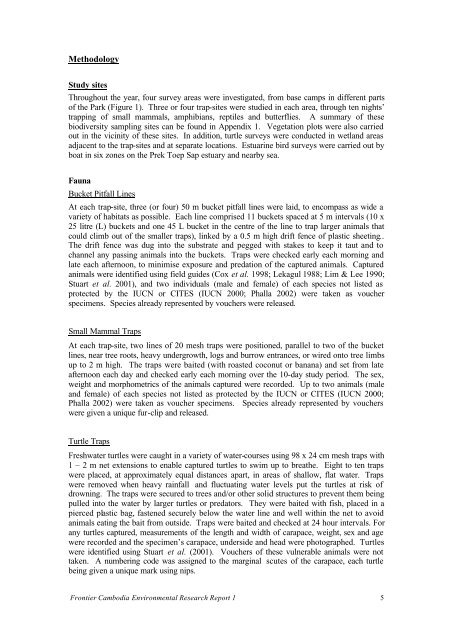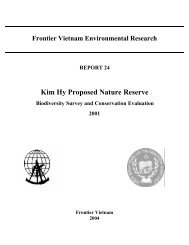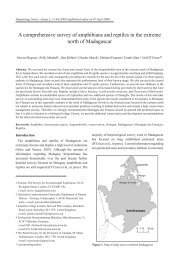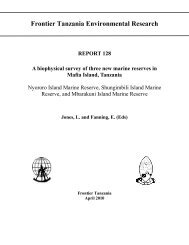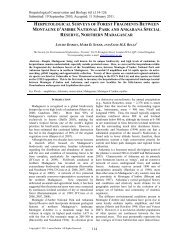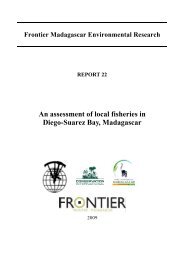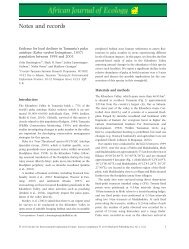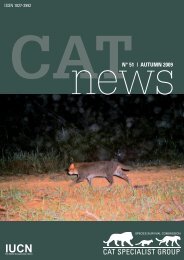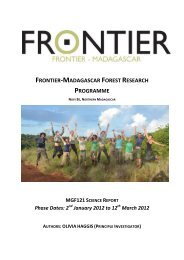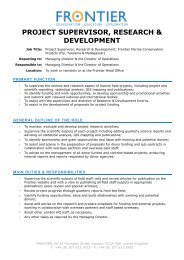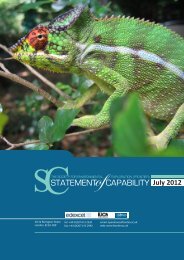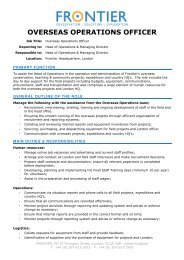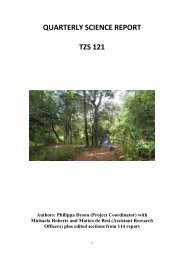Ream National Park Twelve Month Report
Ream National Park Twelve Month Report
Ream National Park Twelve Month Report
You also want an ePaper? Increase the reach of your titles
YUMPU automatically turns print PDFs into web optimized ePapers that Google loves.
Methodology<br />
Study sites<br />
Throughout the year, four survey areas were investigated, from base camps in different parts<br />
of the <strong>Park</strong> (Figure 1). Three or four trap-sites were studied in each area, through ten nights’<br />
trapping of small mammals, amphibians, reptiles and butterflies. A summary of these<br />
biodiversity sampling sites can be found in Appendix 1. Vegetation plots were also carried<br />
out in the vicinity of these sites. In addition, turtle surveys were conducted in wetland areas<br />
adjacent to the trap-sites and at separate locations. Estuarine bird surveys were carried out by<br />
boat in six zones on the Prek Toep Sap estuary and nearby sea.<br />
Fauna<br />
Bucket Pitfall Lines<br />
At each trap-site, three (or four) 50 m bucket pitfall lines were laid, to encompass as wide a<br />
variety of habitats as possible. Each line comprised 11 buckets spaced at 5 m intervals (10 x<br />
25 litre (L) buckets and one 45 L bucket in the centre of the line to trap larger animals that<br />
could climb out of the smaller traps), linked by a 0.5 m high drift fence of plastic sheeting..<br />
The drift fence was dug into the substrate and pegged with stakes to keep it taut and to<br />
channel any passing animals into the buckets. Traps were checked early each morning and<br />
late each afternoon, to minimise exposure and predation of the captured animals. Captured<br />
animals were identified using field guides (Cox et al. 1998; Lekagul 1988; Lim & Lee 1990;<br />
Stuart et al. 2001), and two individuals (male and female) of each species not listed as<br />
protected by the IUCN or CITES (IUCN 2000; Phalla 2002) were taken as voucher<br />
specimens. Species already represented by vouchers were released.<br />
Small Mammal Traps<br />
At each trap-site, two lines of 20 mesh traps were positioned, parallel to two of the bucket<br />
lines, near tree roots, heavy undergrowth, logs and burrow entrances, or wired onto tree limbs<br />
up to 2 m high. The traps were baited (with roasted coconut or banana) and set from late<br />
afternoon each day and checked early each morning over the 10-day study period. The sex,<br />
weight and morphometrics of the animals captured were recorded. Up to two animals (male<br />
and female) of each species not listed as protected by the IUCN or CITES (IUCN 2000;<br />
Phalla 2002) were taken as voucher specimens. Species already represented by vouchers<br />
were given a unique fur-clip and released.<br />
Turtle Traps<br />
Freshwater turtles were caught in a variety of water-courses using 98 x 24 cm mesh traps with<br />
1 – 2 m net extensions to enable captured turtles to swim up to breathe. Eight to ten traps<br />
were placed, at approximately equal distances apart, in areas of shallow, flat water. Traps<br />
were removed when heavy rainfall and fluctuating water levels put the turtles at risk of<br />
drowning. The traps were secured to trees and/or other solid structures to prevent them being<br />
pulled into the water by larger turtles or predators. They were baited with fish, placed in a<br />
pierced plastic bag, fastened securely below the water line and well within the net to avoid<br />
animals eating the bait from outside. Traps were baited and checked at 24 hour intervals. For<br />
any turtles captured, measurements of the length and width of carapace, weight, sex and age<br />
were recorded and the specimen’s carapace, underside and head were photographed. Turtles<br />
were identified using Stuart et al. (2001). Vouchers of these vulnerable animals were not<br />
taken. A numbering code was assigned to the marginal scutes of the carapace, each turtle<br />
being given a unique mark using nips.<br />
Frontier Cambodia Environmental Research <strong>Report</strong> 1<br />
5


